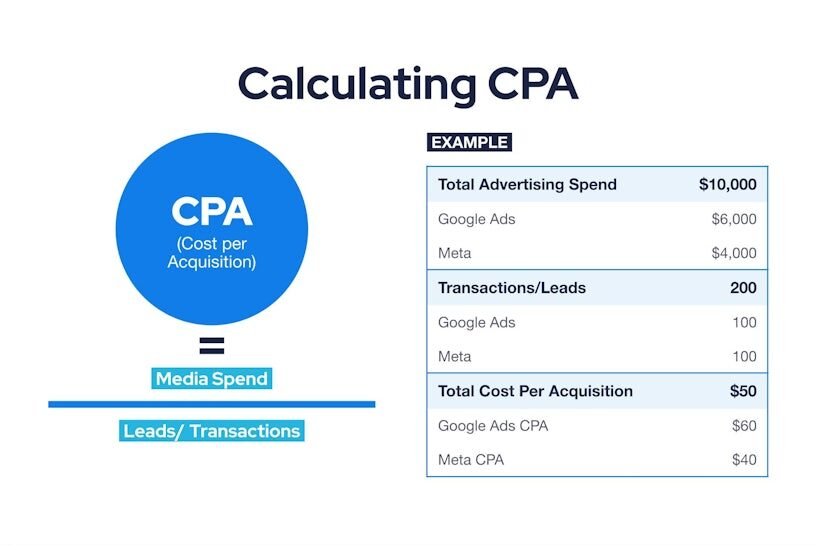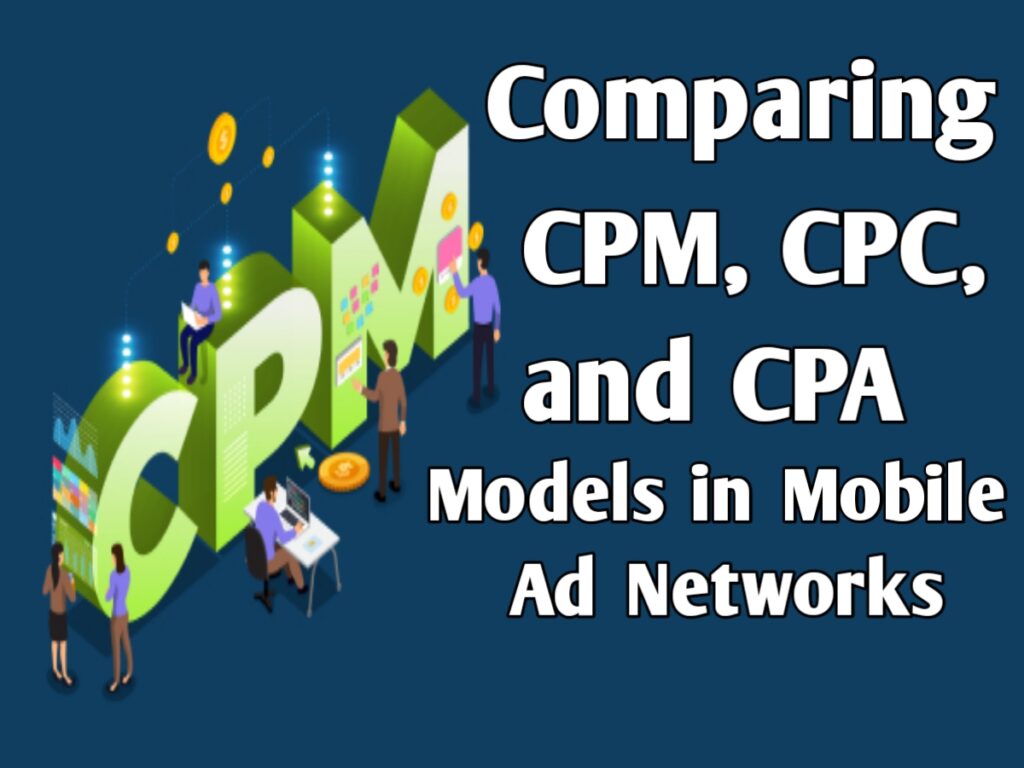Mobile ad networks play a critical role in digital marketing, connecting advertisers with users across various devices. Knowing which pricing model to choose—CPM, CPC, or CPA—can significantly impact the success of your campaigns. This guide breaks down each model to help you decide which aligns with your marketing goals.
Understanding Mobile Ad Networks

Mobile ad networks are platforms that connect advertisers with publishers to display ads within mobile apps. These networks are vital as they help monetize apps and reach targeted audiences efficiently. Various advertising models have emerged, including CPM, CPC, and CPA, each offering unique benefits and challenges.
Table of Contents
1. CPM (Cost Per Mille) Model

Definition and Explanation
CPM, or Cost Per Mille, means paying a fixed price for every 1,000 impressions an ad receives. It’s an essential metric for campaigns focused on brand awareness.
How CPM is Calculated
CPM is calculated by dividing the total cost of the ad campaign by the number of impressions (in thousands).
Key Characteristics
- Ideal Use Cases: Best suited for brand awareness campaigns.
- Best For: Maximizing visibility rather than immediate actions.
Advantages of CPM
- Predictable Budgeting: Offers consistency in monthly ad spending.
- High Visibility Potential: Increases brand recognition without needing clicks.
Disadvantages of CPM
- Not Performance-Based: Doesn’t guarantee engagement or conversion.
- Risk of Low Engagement: High visibility might not translate into action.
Common CPM Pricing Strategies
- Fixed Pricing: A set cost per thousand impressions.
- Auction-Based Pricing: Rates vary depending on demand.
Examples of CPM in Action
Many large brands use CPM for launching product awareness campaigns across social media and display networks.
2. CPC (Cost Per Click) Model

Definition and Explanation
CPC, or Cost Per Click, means advertisers only pay when someone clicks on their ad. This model is favored by those seeking immediate user interaction.
How CPC is Calculated
The total cost of the ad campaign is divided by the number of clicks received.
Key Characteristics
- Engagement-Driven: Focuses on getting users to take action.
- Useful in Direct Response Campaigns: Drives clicks to landing pages.
Advantages of CPC
- Performance-Based Pricing: You pay only for actual engagement.
- Can Lead to Higher ROI: Direct correlation between cost and user interest.
Disadvantages of CPC
- Cost Fluctuations: Prices can change based on competition.
- Potential for Click Fraud: Automated clicks can inflate costs.
Common CPC Pricing Strategies
- Manual vs Automated Bidding: Manual allows control, while automated optimizes for conversions.
- Bid Adjustments Based on Performance: Tweaking bids to align with goals.
Examples of CPC in Action
Retailers commonly use CPC to promote products, focusing on sales and conversions through clicks.
3. CPA (Cost Per Acquisition) Model

Definition and Explanation
CPA, or Cost Per Acquisition, means paying only when a specific action is completed, like a sale or registration.
How CPA is Calculated
Divide the total cost of the advertising campaign by the number of successful conversions.
Key Characteristics
- Focus on Conversions: Ideal for sales-driven campaigns.
- Perfect for Performance Marketing: Aligns costs with tangible outcomes.
Advantages of CPA
- Maximal Cost Efficiency: Only pay when a desired action occurs.
- Aligns with Business Goals: Directly linked to revenue-generating activities.
Disadvantages of CPA
- Complexity in Tracking Conversions: Requires sophisticated tracking tools.
- May Require Higher Upfront Costs: Often needs a larger budget for effective testing.
Common CPA Pricing Strategies
- Value-Based Pricing: Costs determined by the potential value of conversions.
- Target CPA Bidding: AI optimizes bids to achieve target cost per acquisition.
Examples of CPA in Action
E-commerce platforms frequently use CPA to ensure that ad spending is directly tied to sales and revenue.
Comparison of CPM, CPC, and CPA
| Model | Definition | Pricing Structure | Optimal Use Cases | Advantages | Disadvantages |
|---|---|---|---|---|---|
| CPM | Cost Per Mille | Cost per 1,000 impressions | Brand awareness | Predictable costs | Not performance-based |
| CPC | Cost Per Click | Pay per click | Engagement & clicks | Performance-based | Cost fluctuations |
| CPA | Cost Per Acquisition | Pay per conversion | Sales-driven | Cost efficiency | Complexity in tracking |
Choosing between these models depends on marketing goals. For brand visibility, CPM excels. CPC suits campaigns needing interaction, while CPA aligns with sales objectives. Learn more about CPA, CPC, and CPM models.
Factors Influencing Model Selection
Campaign Objectives
Determining whether awareness, engagement, or conversion is your primary goal can guide your choice.
Target Audience Characteristics
Understand your audience. High engagement with tech-savvy users might work well with CPC, while broader reach is achieved with CPM.
Budget Considerations
Consider budget limits. CPM offers predictability, while CPC and CPA need adaptive spending strategies.
Historical Performance Data
Evaluating past campaign data helps predict which model might yield the best results.
Industry Benchmarks and Standards
Meeting or exceeding industry benchmarks ensures competitiveness and effectiveness.
Key Metrics to Monitor for Each Model
CPM Metrics
- Impressions: Total times the ad is shown.
- Reach: Unique users who view the ad.
CPC Metrics
- Click-Through Rate (CTR): Percentage of ad views that lead to clicks.
- Average CPC: Average cost for each click received.
CPA Metrics
- Conversion Rate: Percentage of clicks that result in desired actions.
- Average CPA: Average cost for each acquisition.
Best Practices for Each Model
Optimizing CPM Campaigns
- Leverage creative strategies to capture attention.
- Use precise audience targeting tips for broader reach.
Optimizing CPC Campaigns
- A/B test landing pages for improved conversions.
- Use keyword targeting to refine audience reach.
Optimizing CPA Campaigns
- Implement retargeting strategies to encourage conversions.
- Use comprehensive tracking and analytics.
Conclusion
Deciding between CPM, CPC, and CPA depends on your marketing strategy. Understanding each model’s strengths and weaknesses helps align advertising spend with business objectives. Choose wisely to optimize ad performance and drive success in your mobile ad network campaigns. For further reading, explore the best mobile ad networks for 2024.
You may like these:




